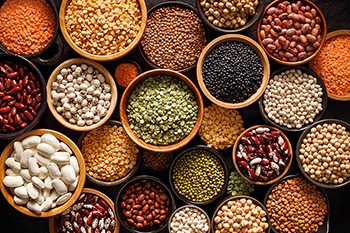|
|
DisplayTitle Pulse Webinar Series
Page Content
Series Summary

The interest in pulses (including peas, lentils, chickpeas and beans) as food ingredients is growing substantially as a result of their nutritional density and environmental sustainability. In recent years there has been significant investment in the value-added processing of pulses to produce an array of ingredient formats; this includes flours, proteins, starches, and fibers. Each respective ingredient will differ based on its nutritional and functional characteristics that are further influenced by the processing method selected and its applied conditions. This webinar series, initiated by the Pulse Division of Cereals & Grain Association, intends to provide an overview of pulses, their derived ingredients, and environmental effects.
Broadcast Date: October 9th, 2020 | 11:00 CDT
View On-Demand Webinar
Webinar SummaryUnlike other products (i.e wheat flour, soybean protein concentrates vs isolate) there are no common definitions or characterization parameters for pulse derived ingredients. It follows that is important to clearly outline all of the processing methods and how they will affect the resulting ingredient as this is one of the few ways to distinguish between ingredient formats given the lack of uniform industry language. The processing methods themselves will each have an affect on the quality and end-use applicability for each ingredient, further emphasizing the need to understand the existing methodology. It is also important to equally emphasize ALL of the co-product produced during the valorization of pulses (i.e starches, fibres) as there is a need to build demand for these ingredients given the heavy media and industry interest on plant proteins.
About the Presenter

|
Janelle Courcelles is Pulse Canada's Senior Manager of Food Innovation and Marketing. Her role involves supporting growth in the pulse ingredient processing sector through global engagement with pulse flour millers and fractionators. In addition to providing marketing and technical support to processors, she is also responsible for identifying technical challenges in pulse processing and facilitating research partnerships. Janelle received her MSc from the University of Manitoba in the department of Food and Human Nutritional Sciences focusing on the effects of genotype and environment on the milling and end-use quality of Canadian wheat. Prior to joining Pulse Canada, she worked in both sales and technical support of analytical equipment related to food processing. |
Broadcast Date: November 30th, 2020 | 11:00am CDT
View On-Demand Webinar
Webinar SummaryPulses are part of legume family which contains dry edible seeds of plants including peas, lentils, beans and chickpeas. Pulses are gluten-free, and they are high in protein, dietary fiber and micronutrients. Pulses are environmentally sustainable crops due to their ability to create a healthy soil by fixing the nitrogen in the soil. In addition, they use less water during production compared to animal-based proteins. Pulses are both nutritionally balanced AND environmentally sustainable attributes that matter more to consumers than ever before. In this webinar we will learn about pulse ingredients and dig into how we can holistically formulate with pulse ingredients in meat and dairy alternatives as well as bakery foods, snacks, and batter and breadings. We will review formulation approaches, discuss complimentary ingredients, provide formulation tools and guides, discuss challenges and how to overcome them.
About the Presenter

|
Dilek Uzunalioglu, Ph.D., is Head of Food Applications at Motif FoodWorks Inc., leading food application development for Motifs' ingredient portfolio designed to improve taste, texture and nutrition of plant-based foods. Prior joining Motif, Dilek led Ingredion Global Bakery & Snack Application team as well as Global Plant Protein application team, developing application capabilities as well as new ingredients including snack texturizers, gluten-free flour systems, fibers, pulse flours and proteins. Dilek is a graduate of the Ph. D. in Food Science program at Rutgers University, Uzunalioglu also holds a bachelor and a master of science degree in food engineering from the Middle East Technical University. She served as a President at Cereals & Grain Association Carbohydrate Division and Engineering & Processing Division. Currently, she is chair for Book Acquisition committee. She published several journal articles, conference papers and two book chapters. She lives with her son and her husband in Winchester, MA. She loves sourdough bread baking and enjoys hiking and biking with her family. |
Broadcast Date: December 8th, 2020 | 11:00am CDT
View On-Demand Webinar
View Presentation
Webinar SummaryThe interest in pulses has diversified their use as ingredients in food products. However, flavors associated with the pulses sometimes limits their broader use in food products. This webinar will highlight pulse flavors and provide an overview of the nature of pulse flavors and several approaches used to mitigate the intensity of the pulse flavor. Topics covered will include plant derived flavors inherent to pulses, flavors derived from oxidation processes, and non-volatile flavors that are associated with bitterness in flour and protein ingredients. Approaches to eliminate or reduce flavors will include a summary of thermal and extraction technologies. Information on the chemistry of the flavors will be a focus, with analytical and sensory data included in the presentation. Information regarding flavor masking will not be presented in this webinar. A variety of pulses will be highlighted in this presentation.
About the Presenter

|
Clifford Hall III completed his bachelor (1988) at University of Wisconsin - River Falls, masters (1991) and doctoral (1996) degrees at the University of Nebraska-Lincoln in the area of Food Science and Technology. Dr. Hall is currently a professor in the Dairy and Food Science Department at South Dakota State University. He oversees the annual U.S. Pulse Quality Survey. He has advised 13 Ph.D. and 16 master's students. He has also mentored over 40 undergraduate researchers. His focus of my research program is the utilization of traditional and non-traditional crops in food products. Examples include omega-3 fortification, from flaxseed, in extruded bean snacks, use of pulse proteins (chickpea) as egg replacers, fortification of meat products with texturized pulse proteins, effects of extrusion processing on pulse components and sensory and stability characteristics of pulses, pulse flours and pulse fortified products. Milling of pulses has been a recent focus due to the increasing demand for pulse ingredients by the food industry. In addition, methods for de-flavoring of pulse flours and impacts of storage on pulse composition and functionality have been current areas of research. As a result, his research is a combination of fundamental understanding of the commodity to an applied utilization of the component in a finished product. |
Broadcast Date: January 14th, 2021 | 11:00 am Central
View On-Demand Webinar
Webinar SummaryLifecycle assessment is becoming the de facto tool for sustainability evaluations from carbon footprint water footprint and resource use efficiency. Understanding the strengths and weaknesses of this tool is important in evaluating sustainability claims. This talk will highlight, using pulse production and consumption as a case study, the level of understanding and challenges associated with quantifying sustainable nutrition security. This webinar will provide an introduction to lifecycle assessment for food systems introducing the two main assessment paradigms: attributional and consequential. A detailed case study of US pulse production and consumption will be used to illustrate the application of lifecycle assessment for quantifying sustainability characteristics of food systems. In addition, the benefits and challenges of quantifying the sustainability of pulses through incorporating in the US diet with regard to nutrition will be discussed. An interesting initial finding with regard to environmental sustainability is that the method of cooking pulses has a significant impact on the carbon footprint-unlike many other food products where the impacts are dominated by the production phase.
About the Presenter

|
Greg Thoma, Ph.D. is the Bates Teaching Professor of Chemical Engineering at the University of Arkansas and served as inaugural Director for Research of The Sustainability Consortium. He has led numerous food and agriculture life cycle assessment projects: milk, cheese, milk delivery systems, yogurt, swine, poultry, corn, and beef. He serves on the steering committee for the Swiss National Research Program, “Healthy Nutrition and Sustainable Food Production.” He is the North American subject editor for Agriculture for the International Journal of Lifecycle Assessment and has served on the scientific/technical/organizational committee for numerous international LCA conferences. He has been active with the UN Food and Agriculture Organization’s Livestock Environmental Assessment and Performance (LEAP) Partnership since its inception acting as the Technical Advisory Group Lead/Co-lead for development of the poultry, swine, and large ruminants’ guidelines. He is currently serving on the nutrient cycling and biodiversity technical advisory groups. |
|
